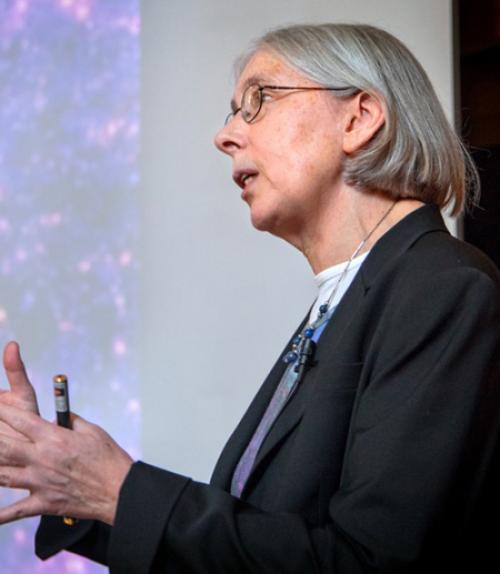Martha Haynes, the Goldwin Smith Professor of Astronomy, led an audience of students and faculty on a “journey across space and time” April 25 in Philip Lewis Hall.
In her Phi Beta Kappa Distinguished Faculty Invitational Lecture Hayes discussed the evolution of the universe through the lens of the rapidly developing field of astronomy. An expert in observational cosmology, galaxy evolution and techniques of radio astronomy, Haynes offered insights from her research as well as from her undergraduate course, “The History of the Universe.”
Opening the lecture with a familiar picture of the night sky, Haynes identified a band of stars and dust as the outline of the Milky Way galaxy. Challenging the audience “to understand what the universe would look like if you could step outside of it, which you can’t,” Haynes presented a physics-based computer simulation of a conglomeration of billions of galaxies.
“The distribution of matter in the universe isn’t smooth, it’s lumpy and bumpy and has structure,” she said.
Exploring this transformation from a smooth to a filamentary structure, Haynes explained how astronomers account for the speed of light to look back in time to when the universe was younger.
“Over time the universe has expanded and gotten bigger; at the same time, gravity acting locally has caused the material to coalesce or collapse, creating structure,” Haynes said. With this overarching theme, she spoke about important moments in the history of the universe from “primordial nucleosynthesis” to the discovery of cosmic microwave background radiation in 1965.
Referring to her work mapping the three-dimensional distribution of galaxies in our universe – which earned her the 1989 Henry Draper Medal for astronomical physics – Haynes said, “A successful scientist doesn’t find all the answers, they find a new paradigm to serve for lots and lots of future work.”
Despite her successes, Haynes acknowledged, “Most of the universe is made up of stuff that we can so badly understand we call dark energy; we don't know what it is, but it makes up 70 percent of the energy density of the universe. … The objective of 21st-century science is to try to better understand what dark matter and dark energy are and how they are distributed.”
Concerning other academic opportunities in astronomy, Haynes said, “The detection and mapping of the polarization of the cosmic background radiation” is “the next step in understanding our universe. … Cornell will play a big role in pursuing this type of research in the next 10 years.”
Haynes concluded her lecture speaking about her involvement in the Cornell-led Cerro Chajnantor Atacama Telescope-prime (CCAT-prime) project building a powerful telescope in northern Chile. “This is a project which is driven by science,” she said, “but is being enabled by technology.”
Haynes was introduced by faculty president of Cornell Phi Beta Kappa Dan Schwarz, the Whiton Professor of English and Stephen H. Weiss Presidential Fellow. The Cornell chapter sponsors one lecture each term and awards annual scholarship prizes to graduating Phi Beta Kappa seniors.
This story also appeared in the Cornell Chronicle.





